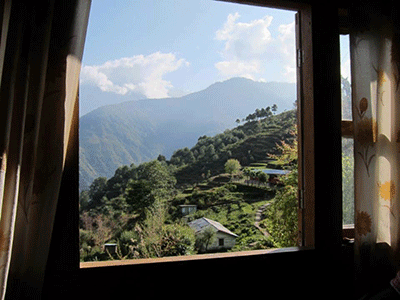Conocemos a Basanta Baral, consultor actual de Namlo Europa en Nepal. Basanta asiste a Namlo Europa en la comunidad de Dhenung, donde está la escuela de Khamdenu, construida por Namlo. Entre otros, es el encargado de la aplicación de los programas de desarrollo sostenible de comunidades que realiza Namlo Europa en Nepal.
Mi nombre es Basanta Baral y nací en la ciudad de Pokhara, una ciudad que ha cambiado muchísimo en los últimos años. A pesar de que la escuela a la que fui cuando era pequeño no tenía las mismas herramientas educativas que pueden existir actualmente, era un buen alumno y siempre obtenía buenos resultados en mis estudios. También jugué a fútbol y a criquet hasta los 22 años.
Años más tarde marché hacia Kathmandu, donde estudié un máster que me abriría las puertas del mundo laboral: tengo experiencia en el mundo de la enseñanza, la banca y el trabajo social. Me gusta mucho viajar y conocer gente diversa allá donde voy.
¿Qué es Namlo para ti?
Namlo tiene un significado simbólico. Aunque pueda parecer una simple cuerda para mucha gente, tiene la capacidad de proporcionar el equilibrio suficiente para llevar cargas pesadas con la frente de uno mismo; así que tiene un significado especial para la población rural del Nepal.
Yo entiendo Namlo como una organización que trabaja para la gente del pueblo, respetando las creencias de los miembros de las comunidades. Además, Namlo cree en la implicación de todos los miembros de la comunidad en todas las fases de los proyectos de desarrollo que realiza. Estoy muy orgulloso del hecho de que Magda tomara una palabra nepalí para nombrar una organización que ayuda al país desde fuera.
¿Cómo de importante es la educación para tu vida?
Es una pregunta complicada… No me puedo imaginar mi vida sin tener educación. La educación recibida me ha proporcionado la forma de vida que tengo actualmente. Los estudios que he cursado a lo largo de mi vida me han aportado habilidades y conocimientos para poder desarrollarme en el mundo laboral.
La educación también me ha ayudado a tener una vida sana, puesto que puedo adoptar las medidas pertinentes para cuidar de mi salud.
Resumiendo, gracias a la educación que he recibido he aprendido a guiar mi vida de mejor manera.
Descríbenos qué haces para Namlo Europa.
Actualmente estoy haciendo de consultor externo a tiempo parcial para Namlo Europa en Nepal, puesto que estoy esperando un hijo con mi mujer.
Visito la comunidad de Dhenung una vez al mes y mi trabajo consiste en estudiar los proyectos de desarrollo comunitario potenciales que podrían ayudar a la población, para ejecutarlos lo antes posible. Por eso estoy en contacto con diferentes grupos de población de Dhenung y realizamos charlas de grupo focalizadas por objetivos concretos, para preparar un informe de evaluación posterior.
Además, cuando llegan voluntarios de Cataluña a Nepal, soy el encargado de acompañarlos hasta la comunidad y de asistirlos con traducciones y lo que sea necesario durante sus tareas de ayuda a la comunidad.
¿Cómo ves la situación actual de tu país?
El Nepal está pasando por varias situaciones complicadas en este momento. En el primer mes del año del calendario nepalí, sufrimos un gran terremoto, del que todavía estamos sufriendo las consecuencias. Miles de personas perdieron sus familiares y sus hogares, y muchas infraestructuras quedaron afectadas. También se vieron afectados muchos monumentos. Por suerte, países vecinos, otros países y organizaciones internacionales ayudaron a las víctimas y están ayudando en la reconstrucción del país.
Por otro lado, la aprobación de la reforma constitucional del pasado mes de septiembre desencadenó huelgas en la parte sur del país, denominada el Tarai. A la vez, según el gobierno nepalí las oficinas aduaneras de la india están retardando y bloqueando la circulación entre los dos países como medida de presión en contra de la nueva constitución nepalí. Esto está provocando escasez de gran diversidad de elementos como combustible, gas para cocinar, e incluso medicinas. El transporte está sufriendo también las consecuencias, y los precios para moverse por el interior del país se han incrementado más del doble.
Aún así, la situación es todavía peor en las zonas rurales del país. Las personas y los restaurantes han vuelto a utilizar leña para cocinar, en caso de tener acceso. En las zonas urbanas solo hay electricidad, y tampoco está disponible durante todo el día. Tenemos que ser conscientes de que está empezando el invierno y la situación se puede complicar.
El sector del turismo ha sufrido muchísimo, sobre todo en esta temporada alta, puesto que están llegando muy pocos turistas al país, sobre todo para visitar las zonas rurales, donde radica la belleza natural del país.
Deseo de todo corazón que el diálogo entre el gobierno y los líderes del Tarai llegue a buen puerto y que el país vuelva a la normalidad la antes posible. El restablecimiento de la frontera con la China, que sufrió graves consecuencias por el terremoto, también mejorará notablemente la situación, puesto que podremos traer combustible y alimentos desde allí.
En general, Nepal se enfrenta ahora a una situación muy difícil tanto en términos humanitarios como económicos.


 Català
Català English
English










